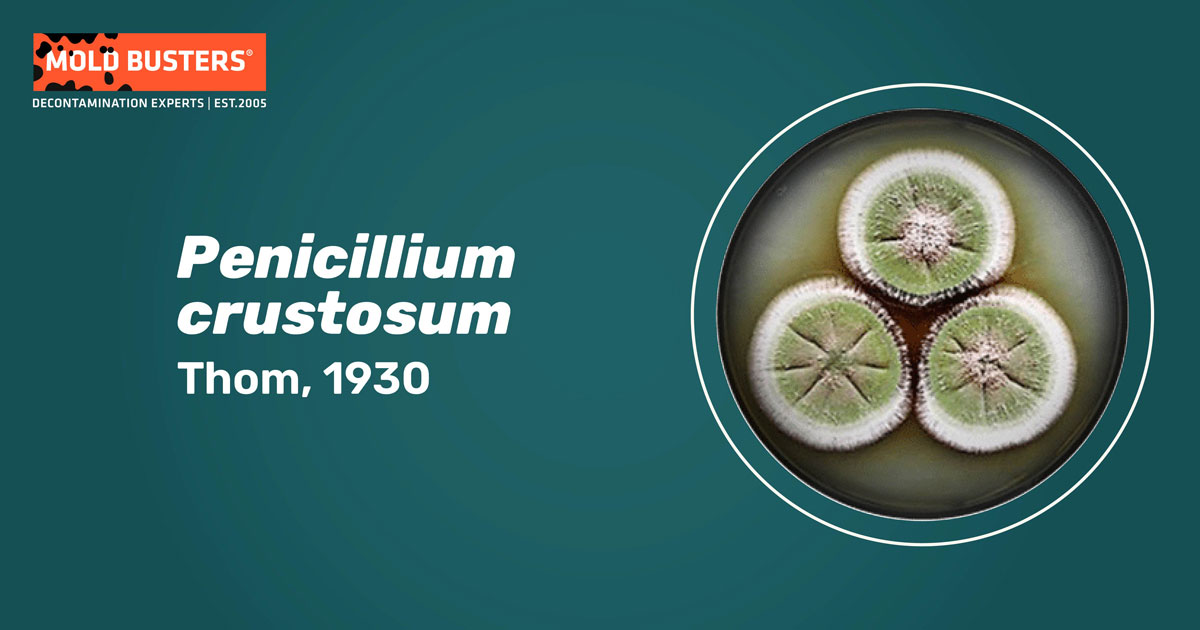Thom, 1930
What is Penicillium crustosum?
Ever since the discovery of penicillin by Alexander Fleming in 1928, Penicillium species have been in the medical and scientific spotlight due to the immense importance of their secondary metabolites. At the same time, some members of the Penicillium genus produce less known and potentially harmful compounds, such as penicillic acid (1). Penicillium crustosum is one such mold. This grayish-green fungus often contaminates various types of foods by producing several mycotoxins. These toxins have tremorgenic properties that affect the nervous system and cause tremors, vomiting, and other health problems in pets, farm animals, and humans in rarer cases (1, 2).

What does Penicillium crustosum look like?
Penicillium crustosum forms colonies usually 20–40 mm (0.8–1.6-inch) in diameter, with a plane or less commonly radially marked surface. Surface texture can be velutinous or granular with a powdery appearance. The colony usually appears white or dull green due to heavy conidial production over the entire colony area. All conidial elements are robust and large. Conidiophores (conidia-supporting structures) are 200–400 µm long, with rough walls. Conidia (asexual spores) are spherical or slightly ellipsoidal, 3.0–4.0 µm in diameter. They have smooth walls and are formed in long regular chains (16).
Where is Penicillium crustosum found?
Penicillium crustosum can grow in temperatures from -2 to 30°C (28-86°F), with the optimum growth temperature around 25°C (77°F). It can grow in both acidic and basic environments, as its pH tolerance ranges from 2 to 10. These characteristics make it very adaptable and ubiquitous. This mold can primarily be found in food items, and it often contaminates meat, chicken eggs, cheese, corn, nuts, and fruits (plums, nectarines, and apples). It has also been isolated from the rhizosphere, which is the soil surrounding the roots of these agricultural plants (3-6).
P. crustosum has also been identified as an air contaminant in humid living spaces. However, it is still insufficiently researched if exposure to this mold’s spores or hyphal fragments can induce an allergic reaction or an asthmatic attack (4, 7). The adaptability and the ability of this mold to withstand low temperatures are best represented by the fact that it has also been found in glacial ice and seawater from the Arctic Ocean, suggesting that it can develop colonies on refrigerated food (4).
What are mycotoxins produced by Penicillium crustosum?
Penicillium crustosum produces several mycotoxins, the most prominent and the most toxic being the penitrem A. Other compounds from the same group produced by P. crustosum are penitrems B-F, which are less toxic but potentially dangerous. Throughout the years, penitrem A poisonings have mostly been reported in dogs and cattle due to ingestion of contaminated food (8-10).
A case study analyzing six cases of dog poisoning by penitrem A has demonstrated different effects this mycotoxin can have on the animal, depending on the ingested amounts of contaminated food and treatment of the poisoning. With a timely reaction from the owners and proper treatment from the veterinarian, three of the six dogs recovered relatively quickly within a few days. On the other hand, two dogs had lasting consequences, while the last dog was euthanized the day after the poisoning due to intense body convulsions (10).
This tremorgenic mycotoxin affects the central nervous system and causes tremors, convulsions, vomiting, ataxia (problems with coordination, walking, and articulation), and tachycardia. It is theorized that penitrem A affects the Ca2+ regulated K+ channels which are important ion channels in the cell membrane that regulate the membrane potential and control the release of neurotransmitters in the brain. This toxin most likely inhibits the release of a neurotransmitter called gamma-aminobutyric acid or GABA (10 – 13), the primary inhibitory neurotransmitter in the brain. Some of the more important physiological processes controlled by GABA are the formation of new synapses in the central nervous system, maintaining normal muscular tone, serotonin release, and regulation of hormone secretion. Disruption of GABA synthesis and release in synapses is also linked to anxiety and depression (14).
Additionally, penitrem A is believed to increase the production of reactive oxygen species (ROS), also called free radicals. ROS are a group of oxygen radicals, highly reactive molecule modifications of oxygen with unpaired electrons, generally produced in the body as a byproduct of normal metabolism. When these molecules are produced at a normal rate, certain enzymes in the body in charge of removing them or neutralizing them protect the cells from damage. However, when their concentration rises above the normal level, they can lead to oxidative stress. Because of their need to pair their free electrons, ROS interact with and oxidize lipids and proteins and DNA that they come into contact. This can lead to serious cellular damage and even cell death (12, 15).
P. crustosum also produces thomitrems, which are structural analogs to penitrems and roquefortine C. There are speculations that these secondary metabolites might also be tremorgenic or might increase the effect of penitrem A. However, there is insufficient research on these compounds’ effects on mammals to support these suspicions (11).
Is Penicillium crustosum dangerous for humans?
Much like in the case of dogs and other animals, ingesting food contaminated by P. crustosum can lead to poisoning due to penitrem A production. As stated above, once ingested, penitrem A enters the bloodstream and then passes the blood-brain barrier, reaching the brain and causing neurological disease. Symptoms in previously observed cases of human poisonings include body tremors, nausea and vomiting, hyperthermia, double vision, and bloody diarrhea (12).
So far, P. crustosum has not been identified as a cause of allergic reactions or asthma. However, it does seem to synthesize mild allergens, which in rare cases might irritate highly sensitive or immunocompromised individuals (13). Penicillium crustosum should be regarded as a potential health hazard, and any food item suspected of contamination by this mold should be immediately discarded. Furthermore, if there are any suspicions of air contamination by this mold in living spaces, it is advised to contact decontamination experts.

Did you know?
Bathrooms in Canada are the most affected by the Basidiospores mold group?! Find out more exciting mold stats and facts inside our mold statistics page.
References
- Pitt, J. I. (2002). Biology and ecology of toxigenic Penicillium species. Mycotoxins and food safety, 29-41.
- Samson, R. A., & Pitt, J. I. (Eds.). (1990). Modern concepts in Penicillium and Aspergillus classification(Vol. 185). Springer Science & Business.
- El-Banna, A. A., & Leistner, L. (1988). Production of penitrem A by Penicillium crustosum isolated from foodstuffs. International journal of food microbiology, 7(1), 9-17.
- Sonjak, S., Frisvad, J. C., & Gunde-Cimerman, N. (2005). Comparison of secondary metabolite production by Penicillium crustosum strains, isolated from Arctic and other various ecological niches. FEMS microbiology ecology, 53(1), 51-60.
- Demjanová, S., Jevinová, P., Pipová, M., & Regecová, I. (2021). Identification of Penicillium verrucosum, Penicillium commune, and Penicillium crustosum isolated from chicken eggs. Processes, 9(1), 53.
- Duduk, N., Bekčić, F., Žebeljan, A., Vučković, N., & Vico, I. (2021). First report of blue mold caused by Penicillium crustosum on nectarine fruit in Serbia. Plant Disease, 105(2), 487.
- Reboux, G., Rocchi, S., Vacheyrou, M., & Millon, L. (2019). Identifying indoor air Penicillium species: a challenge for allergic patients. Journal of medical microbiology, 68(5), 812-821.
- Rundberget, T., Skaar, I., & Flåøyen, A. (2004). The presence of Penicillium and Penicillium mycotoxins in food wastes. International Journal of Food Microbiology, 90(2), 181-188.
- Neurotoxicity of Penicillium crustosum secondary metabolites – Tremorgenic activity of orally administered penitrem A and thomitrem A and E in mice
- Eriksen, G. S., Jäderlund, K. H., Moldes-Anaya, A., Schönheit, J., Bernhoft, A., Jaeger, G., … & Skaar, I. (2010). Poisoning of dogs with tremorgenic Penicillium toxins. Medical mycology, 48(1), 188-196.
- Berkefeld, H., Fakler, B., & Schulte, U. (2010). Ca2+-activated K+ channels: from protein complexes to function. Physiological reviews, 90(4), 1437-1459.
- Berntsen, H. F., Bogen, I. L., Wigestrand, M. B., Fonnum, F., Walaas, S. I., & Moldes-Anaya, A. (2017). The fungal neurotoxin penitrem A induces the production of reactive oxygen species in human neutrophils at submicromolar concentrations. Toxicology, 392, 64-70.
- Sevinc, M. S., Kumar, V., Abebe, M., Lemieux, M., & Vijay, H. M. (2014). Isolation, expression and characterization of a minor allergen from Penicillium crustosum. Medical mycology, 52(1), 81-89.
- Watanabe, M., Maemura, K., Kanbara, K., Tamayama, T., & Hayasaki, H. (2002). GABA and GABA receptors in the central nervous system and other organs. International review of cytology, 213, 1-47.
- Bayr, H. (2005). Reactive oxygen species. Critical care medicine, 33(12), S498-S501.
- Pitt JI, Hocking AD. Fungi and food spoilage. Vol. 519. Springer; 2009.
- Featured photo image, assessed from paradigmchange.me.

Get Special Gift: Industry-Standard Mold Removal Guidelines
Download the industry-standard guidelines that Mold Busters use in their own mold removal services, including news, tips and special offers:

Written by:
Ema Zivkovic
Mycologist
Mold Busters
Edited by:
Dusan Sadikovic
Mycologist – MSc, PhD
Mold Busters
